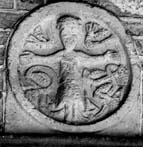Select a site alphabetically from the choices shown in the box below. Alternatively, browse sculptural examples using the Forward/Back buttons.
Chapters for this volume, along with copies of original in-text images, are available here.
Object type: Round-headed panel
Measurements: H. 54 cm (21.25 in); W. 52 cm (20.5 in); D. Built in
Stone type: Very heavily coated with orange paint/plaster. There is a very small area on the south-west quadrant relatively free of coating which exposes a noncalcareous, fine-grained sandstone. Stone type unknown
Plate numbers in printed volume: Pl. 39
Corpus volume reference: Vol 7 p. 91-2
(There may be more views or larger images available for this item. Click on the thumbnail image to view.)
The panel is rectangular with a circular top, in which, within a broad flat frame 4 cm wide, is a figure in a Crucifixus position, surrounded by plant elements and serpentine forms. The figure is standing upright with feet side by side and arms extended, and the body is carved in very deep relief. His head is wedgeshaped but the features are obscured, although there are slight traces of a beard and moustache; the eyes are large and globular, and the ears are set high under a mop of short hair. The dress of the figure can hardly be classified as 'loincloth' or 'robed' (see Coatsworth 1979, I, 108, 177). There is some covering on the torso with what appears to be cutaway points, possibly a belt at the waist and a short 'tunic' marked with tight crinkled folds. On either side of the figure's head float two plant-like features, and filling the gap on either side of his body are writhing plant and serpent forms which seem to emerge from behind his legs and terminate in berry bunches, leaves with sunken centres, and to his right what could be a serpent head.
Appendix A item (stones dating from Saxo-Norman overlap period or of uncertain date).
This bizarre piece was described by Pevsner (1954) as Norman and it may well be of that date. Nevertheless there are parallels for a Crucifixus with feet side by side, arms outstretched, and without cross or halo in late Northumbrian crosses (e.g. Stanwick 7 and Thornton Steward 5 (Lang 2001, ills. 768 and 807)) — and indeed this stance has been seen as iconographically typical of pre-Conquest crucifixion scenes — as well as the doubtful piece from Wareham which has been variously described as Anglo-Saxon and thirteenth century (p. 130, Ill. 541). The scattered elements of plants could be seen as post-Conquest, but the filling-in of the background in this busy way is also found on the Newent 'Edred' slab, Gloucestershire (Zarnecki 1953c, pl. III), although there the crowd of figures and birds surrounding the cross and the crucified can be sorted into figures normally attendant at the Crucifixion and eschatological images. Here one might see the plant forms and the serpent as elements recalling the Fall which Christ redeemed by his passion (cf. the Newent shaft, Gloucestershire (Kendrick 1938, pl. LXXVII.1) and Dacre 2, Cumberland (Bailey and Cramp 1988, ill. 245)).
This is clearly an example of local carving, as can be seen in the shape of the head, the huge eyes and the strange dress, but there may have been some more deeply theological model behind it.



